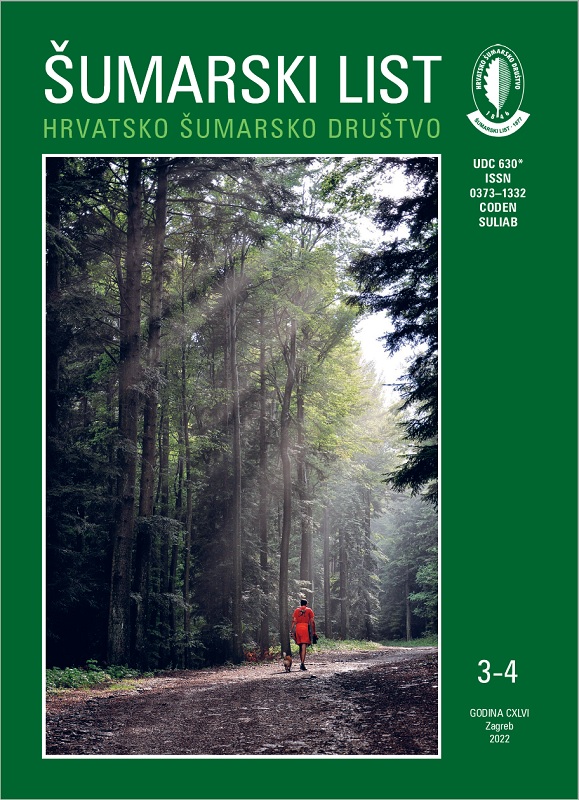
broj: 3-4/2022
pdf (12,34 MB) |
|
||||||||||||||
| RIJEČ UREDNIŠTVA | ||
| Uredništvo | ||
| Do we use biomass as an energy source? If so, how do we use it? pdf HR EN | 101 | |
| IZVORNI ZNANSTVENI ČLANCI | ||
| David Janeš, Andreja Đuka, Ivica Papa, Tibor Pentek, Maja Moro, Ivan Žarković, Tomislav Poršinsky | UDK 630* 686 + 463 (001) https://doi.org/10.31298/sl.146.3-4.1 | |
| Indicators of primary forest accessibility in different terrain categories pdf HR EN | 103 | |
| Kristijan Tomljanović, Marijan Grubešić, Danko Diminić, Milan Poljak, Jelena Kranjec Orlović | UDK 630* 156 + 451 (001) https://doi.org/10.31298/sl.146.3-4.2 | |
| Red deer (Cervus elaphus L.) damage on stands of narrow-leaved ash (Fraxinus angustifolia Vahl) of Middle Posavina pdf HR EN | 117 | |
| Summary Forest ecosystems are complex systems where it is often hard to predict and explain mutual activities and interactions of individual factors. Different species of big game make an inseparable part of these ecosystems. Game, particularly big ruminants and wild boar are in a constant interaction with the flora of the area they inhabit. Their positive and negative effects vary during different forest stand phenophases and depend on the forest stand age, presence and number of different game species, availability of food, etc. The negative effects of big game on forest stands have been studied worldwide and in Croatia as well. The focus of this research was to analyse the bark damage induced by red deer on young trees of narrow-leaved ash. The research was conducted in two narrow-leaved ash forest stands situated in the Sava river basin in Croatia, where red deer is known to be present. The obtained results indicate that debarking (bark peeling) of young trees starts immediately upon the removal of the protective fence which is usually put up around forest stands during the regeneration period. Diameter at the breast height (DBH) of damaged narrow-leaved ash trees varied from 2 to 18 cm. In trees of greater diameter, new bark peeling didn’t occur, and damage induced in previous years became less conspicuous due to the formation of thicker bark layer. Bark damage was visible from the root collar (ground level) up to 190 cm of the stem height. With the increase of DBH (in the range from 2 to 18 cm), the girdling intensity, i.e., the cumulative damage from previous years increased as well. In some research plots the damage was visible on all narrow-leaved ash trees. Bark damage induced by red deer was not observed on the pedunculate oak and indigo bush, which were the two most common woody species in the researched area just after narrow-leaved ash. Conducted bark analysis didn’t indicate that the lack of nutrients, soluble sugar or minerals is the reason for the extensive bark peeling of the narrow-leaved ash bark. Key words: narrow-leaved ash; tree damage; big game; red deer | ||
| Mustafa Arslan, Arzu Ucar Turker, Isa Tas, Arzu Birinci Yildirim, Erva Ozkan | UDK 630* 423 (001) https://doi.org/10.31298/sl.146.3-4.3 | |
| Determination of some phenolic substances in six different populations of turkish hazel (Corylus colurna L.) leaves and comparison of phenolic fluctuation with water deficiency pdf HR EN | 127 | |
| Ender Bugday | UDK 630* 261 (001) https://doi.org/10.31298/sl.146.3-4.4 | |
| A GIS based landslide susceptibility mapping using machine learning and alternative forest road routes assessment in protection forests pdf HR EN | 137 | |
| PRETHODNO PRIOPĆENJE | ||
| Zdravko Dolenec | UDK 630* 148.2 https://doi.org./10.31298/sl.146.3-4.5 | |
| Dates of arrival of the Eurasian golden oriole (Oriolus oriolus L.) in decidious forest in relation to increase of local air temperature in NW Croatia pdf HR EN | 149 | |
| PREGLEDNI ČLANCI | ||
| Matija Bakarić, Ivan Martinić, Mario Šporčić, David Mijoč, Matija Landekić | UDK 630* 641 https://doi.org/10.31298/sl.146.3-4.6 | |
| Entrepreneurial infrastructure and entrepreneurship in forestry of Croatia – possibilities and perspectives pdf HR EN | 153 | |


